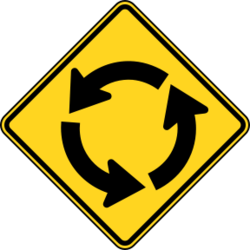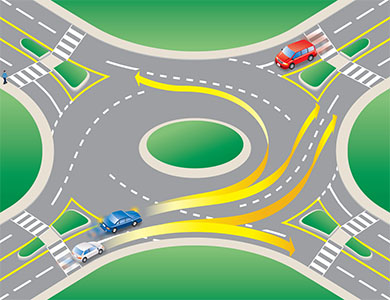
There is one New Year's resolution that I hope British Columbia motorists will be making: learn how to navigate a roundabout. It's simple, really. If your driver's test was many years ago, the BC Ministry of Transportation and Infrastructure posts detailed instructions on its web site along with step-by-step videos. Roundabouts are now commonplace in BC and elsewhere in Canada, but many motorists seem to be dazzled and confused when they encounter one. At UBC we have two roundabouts on 16th Avenue, which has given me plenty of opportunity to observe common mistakes motorists make. But let's start with the rules for using a two-lane roundabout:
- Approach: Reduce your speed and choose your lane. Pay attention to the road signs that may designate lanes. Watch carefully for pedestrians and cyclists on crosswalks. Yield to pedestrians and cyclists on crosswalks.
- Yield: Look left and yield to traffic that is already in the roundabout. Do not force your way in but wait for a safe gap in the traffic. Vehicles already in the roundabout have the right-of-way.
- Enter: Enter the roundabout to your right and continue counter-clockwise until you reach your exit. Do not stop once you are in a rondabout unless it is necessary to avoid a collision. Do not change lanes in the roundabout. If you are in the inside lane and you miss your exit, continue around until you meet your exit again.
- Exit: Use your right-turn signal before exiting and watch for pedestrians and cyclists using the crosswalks.

Source: Ontario Ministry of Transportation,
Driver's Handbook, Diagram 2-37.
Roundabouts usually have two lanes. Always use the right lane if you want to use the first exit (to turn right). Always us the left lane if you want to take the third exit (to turn left). See the picture above. Many errors are due to motorists choosing the wrong lane, then trying to correct it by making sudden dangerous driving maneuvers. So what are common mistakes people make when using a roundabout?
Mistake #1: The Left-Turn Signal. There is no such thing as a left turn in a roundabout. You do not need to signal upon entering a roundabout as there is only one direction in which you can enter. A left-turn signal is utterly confusing, redundant, and plain silly. It is also annoying. It provides no useful information for the driver behind you. Even driving instructors often get that wrong: it appears that they haven't read the ICBC Rules of the Road for BC. If you are a driving instructor and you are teaching your students to signal left when entering a roundabout in the left lane, you are teaching your students bad practice that is not consistent with ICBC rules. Technically, it is not a violation, but it is bad practice. I often see drivers (including driving schools) signalling left going through the roundabout, in their mind "making a left turn" by taking the 3rd exit. But how are other drivers supposed to know where you entered the roundabout? The danger is that the left turn signal is still in use when the motorists is exiting the roundabout, instead of using the right signal to exit, as is required. Most vehicles automatically turn off the signal when you turn in the opposite direction, but the gentle right turn entering into a roundabout may not be sufficient for disengaging the left-turn signal. Repeat: do not signal entering a roundabout. It is not against the law, but it is silly and dangerous.
Mistake #2: Entering without Yielding. Drivers already in the roundabout have the right of way. Yet, many drivers seem to believe that those drivers need to yield to them as entering vehicles are to the right of vehicles already in the roundabout. To avoid any such confusion, roundabouts have yield signs. Obey them. Slow down, and do not force yourself into the roundabout until there is a sufficient gap. I often see drivers not slowing down as they don't see traffic that is already in the roundabout, sometimes obscured by the central island that can block view of the other side. By the time the vehicle in the roundabout becomes visible, only slamming on the brakes will prevent a collision. When you approach a roundabout, slow down to 20-30 km/h. Yes, some drivers can navigate a roundabout at 50 km/h, but a roundabout is not a place to show off your stunt-driving skills. Remember: safety first.
Mistake #3: Miscalculating Gaps. This is both a matter of safety and etiquette. If you are forcing yourself into a gap so that a motorist who is already in the roundabout has to slam on the brakes, you are bullying your way into the roundabout. Perhaps you like being a bully, but don't be surprised if you get honked at. Forcing yourself into a gap is unsafe and rude. What's the rush? A few extra seconds and you'll probably find a safe spot to enter the roundabout. Courtesy is the Canadian way: be polite and wait.
Mistake #4: Changing Lanes. Roundabouts in Canada are designed in such a way that you do not need to change lanes. Yes, there are roundabouts in European cities that have many more lanes than two, but traffic planners in Canada and the United States have been trying to keep things simple for us. Enter in the right lane if you wish to turn right (take the first exit), and enter in the left lane if you with to turn left (take the third exit). You can usually use either the left or the right lane to continue straight (take the second exit). Do not change lanes in a roundabout.
Mistake #4: Exiting without Signalling. One of the most frustrating experiences with motorists in a roundabout is the lack of signalling upon exiting. Yes, it's required. When you fail to signal, other motorists are assuming that you are continuing in the roundabout. This prevents other motorists from entering the roundabout because they are expecting that they have to yield to you. This is inefficient and impolite. Signal your intention to exit.
Mistake #5: Exiting Too Fast. Some motorists speed up after entering the roundabout and leave the roundabout with quite some speed. But watch out: you may still have to yield to pedestrians and cyclists crossing the street on the exit's crosswalk. Sometimes they are hard to see, especially at night and on rainy days. Slow down: a roundabout exit is not an on-ramp to the autobahn where you can show off your car's superior acceleration.
There are also some practical tips. Buses and trucks often need extra space, especially when roundabouts are a bit tight. (That's the reason why many roundabouts have an extra apron around the central island.) Keep your distance. Give large vehicles some extra space as they may (need to) intrude into your lane. If in doubt, err on the side of caution and yield.
You may also wonder about the difference between a traffic circle and a roundabout. A roundabout usually has two lanes, while a traffic circle only has one. A traffic circle often looks like an ordinary intersection with a central island. To make a left turn, you navigate around the island in a counter-clockwise direction the same way as in a roundabout. Often, traffic circles do not have explicit signage, so you need to remember the rules that apply. Importantly, give right-of-way to any vehicle already in the intersection, and if you enter a traffic circle a the same time as another driver, the vehicle to the right has the right of way. In that sense a traffic circle is a bit more demanding because you may have to yield to the left and right.
And what happens if you are in a roundabout when you hear the sirens from an emergency vehicle? Emergency vehicles have the right of way, so avoid blocking a traffic circle or roundabout. Stop for the emergency vehicle before entering a roundabout, or exit the traffic circle or roundabout and then stop to allow the emergency vehicle to pass.
Are roundabouts better than four-way intersections?
Roundabouts are often and correctly regarded as safer than traditional intersections as they pose fewer points of conflict between vehicles, thus reducing the potential for serious accidents and injuries. The potential for serious collisions is also reduced by the much lower speed in a roundabout. Red-light violations often have much more serious consequences when an offending vehicle is hit by another side-on going at a normal speed of 50 km/h, or higher where permited. Safety is a big plus for roundabouts. The US Department of Transportation found (see references below) that roundabouts reduced accidents by 29% and injuries by 51%.
‘A roundabout that operates within its capacity will generally produce lower delays than a signalized intersection operating with the same traffic volumes.’
Efficiency is another big plus for roundabouts. The capacity of a roundabout depends on the amount of conflicting traffic, i.e., vehicles already in the roundabout at each roundabout entry. High conflicting volumes reduce the opportunities for vehicles to enter the roundabout, thus reducing the capacity of a particular approach leg. A single-lane roundaobut is sufficient when the sum of entering and conflicting vehicles is less than 1,000 vehicles per hour, and a two-lane roundabout can manage up to 1,800 vehicles per hour. Compared to other alternatives, a roundabout that operates within its capacity will generally produce lower delays than a signalized intersection operating with the same traffic volumes. However, for non-signalized intersections, there are significant differences when roundabouts are compared with two-way stop control (TWSC) and all-way stop control (AWSC). For conventional TWSC intersections, roundabouts offer few advantages. However, if traffic is sufficiently dense to require AWSC, roundabouts provide much better peformance during off-peak hours. When traffic is even denser and intersections are usually controlled by signals, then the directionality of traffic matters. The share of left-turns is a key determinant for replacing traffic signals with roundabouts, and in particular intersections with limited ability to queue left-turners. A high volume of vehicles turning left is handled better by a roundabout than by a left-turn signal at a traditional intersection. Evaluating whether to replace a signal-operated intersection with a roundabout is a good case for a cost-benefit analysis, taking into account economic, environmental, and safety/health concerns. The safety benefits weigh heavily in the calculation. Accident-prone signaled intersections are prime candidates for conversions to roundabouts.
Further readings and sources:
- BC Ministry of Transportation and Infrastructure: How to Use Roundabouts
- City of Vancouver: How traffic circles work
- Ontario Ministry of Transportation: Roundabouts and Drving through roundabouts
- Maclean's Maagazine Editorial Board: A roundabout way of easing congestion, and scaring seniors, October 5, 2011.
- US Federal Highway Administration: Roundabouts: An Informational Guide, FHWA-RD-00-068, March 2000. Updated version, Washington, 2010.
- Tom Vanderbilt: Traffic: Why we drive the way we do, Vintage, 2008.
![[Sauder School of Business]](logo-ubc-sauder-2016.png)
![[The University of British Columbia]](logo-ubc-2016.png)